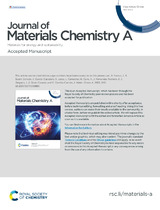2D copper-imidazolate framework without thermal treatment as an efficient ORR electrocatalyst for Zn–air batteries
Autor
Franco, Ana
Salatti Dorado, José Ángel
García-Caballero, Valentín
Lorca, Sebastián
Camacho, Luis
Cano, Manuel
Fernández Romero, A.J.
Delgado, Juan J.
Giner-Casares, Juan J.
Carrillo-Carrión, C.
Editor
Royal Society of ChemistryFecha
2022Materia
Oxygen reduction reactionElectrocatalysts
Electrocatalysis
Zn-air batteries
Metal–organic framework
METS:
Mostrar el registro METSPREMIS:
Mostrar el registro PREMISMetadatos
Mostrar el registro completo del ítemResumen
To face unmet energy demands, the search for more stable, low-cost, and scalable electrocatalyst materials is imperative. Within this context, single-atom catalysts (SACs) have drawn considerable attention due to their maximum atom utilization. With this idea in mind, we have synthesized a new ultrathin and water-stable 2D Cu-based metal-organic framework (2DCIFs), which presents a notable electrocatalytic activity for oxygen reduction reaction (ORR) in alkaline media without the need of calcination, which makes the difference when compared to most MOF-based electrocatalysts. The designed MOF-based SAC consists of single-atom sites (isolated and accessible Cu) coordinated to imidazole carboxylic ligands, giving rise to Cu-N4O actives sites confined into a 2D-nanostructured network. This unique structure, along with the ultrathin nature of nanosheets that favors mass transport and electrical conductivity, and the high chemical stability of these 2DCIFs are the key features of the excellent ORR performance, which occurs by a direct four-electron transfer pathway, an onset potential of 0.86 V vs RHE and a maximum current density of 6.4 mA·cm-2. These good catalytic properties of 2DCIFs have allowed their use as efficient air electrodes in alkaline flooded and all-solid-state Zn-air batteries. In the former case, 2DCIFsbased air electrodes presented a specific power density of 91.2 kW·cm-2·kg-1 and a specific capacity of 296.2 A·h·g-1, significantly exceeding the specific capacity values reported previously for other Cu-based catalysts. Besides, the specific capacity increased to 389.1 A·h·g-1 when 2DCIFs were tested in an all-solid-state Zn-air battery.

